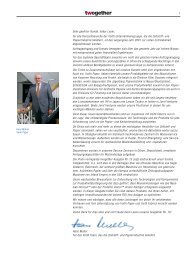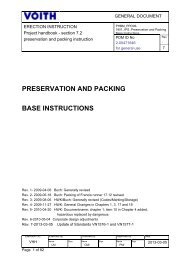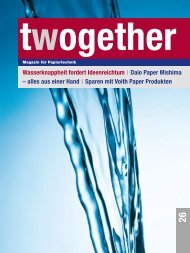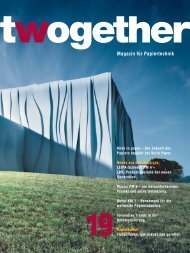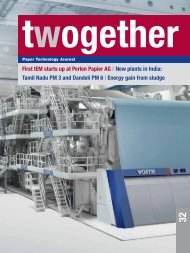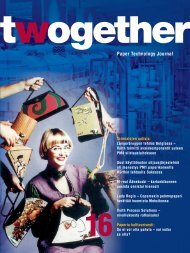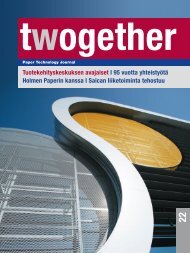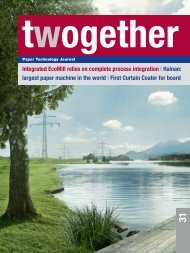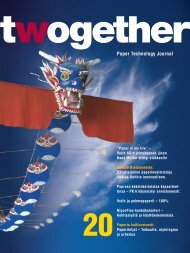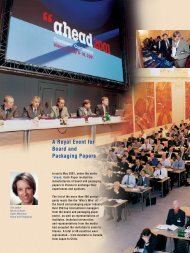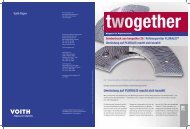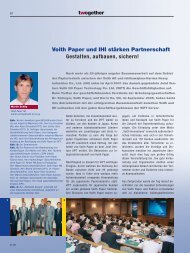Paper Technology Journal 19 - Voith
Paper Technology Journal 19 - Voith
Paper Technology Journal 19 - Voith
Create successful ePaper yourself
Turn your PDF publications into a flip-book with our unique Google optimized e-Paper software.
66<br />
<strong>19</strong>/05<br />
Deep-frozen, dried – and saved<br />
In the night of September 2nd, 2004, a major fire destroyed<br />
large sections of the historic building housing the Duchess Anna<br />
Amalia Library in the German town of Weimar. Local residents, library<br />
employees and several hundred volunteers formed a human chain and<br />
rescued more than half of the irreplaceable original manuscripts and<br />
incunabula from the burning building, which is on the UNESCO World<br />
Cultural Heritage list. Some 30,000 of the library’s volumes were<br />
passed from hand to hand in this way, and a further 30,000 also<br />
escaped the flames, though damaged to a greater or lesser degree.<br />
Most of the books that were rescued,<br />
were already singed or soaked in water<br />
as a result of the fire-fighting operations.<br />
They were taken temporarily to the Book<br />
Preservation Center (ZFB) in Leipzig, an<br />
institute possessing expertise unparalleled<br />
anywhere in the world in the saving<br />
of old books, periodicals and musical<br />
scores for posterity, and the restoration<br />
of old maps and plans, certificates and<br />
official records.<br />
Months after the catastrophe in Weimar,<br />
visitors to the ZFB can still detect a slight<br />
smell of smoke and burning in the air. It<br />
emanates from the ‘patients’ brought<br />
there from the Anna Amalia Library.<br />
These are stacked everywhere in the<br />
workrooms and corridors. Some have already<br />
been given initial treatment, which<br />
involves sorting and classifying them into<br />
groups according to the degree of damage<br />
they have suffered. Group One consists<br />
of largely undamaged items, whereas<br />
Group Six contains those that have<br />
been almost completely destroyed.<br />
The first treatment stage for the books is<br />
to be stored temporarily in large cold<br />
storage chambers at 20 degrees Celsius<br />
below freezing point. Wrapped individually<br />
in muslin or fleece, each soaking wet<br />
book is transformed within a very short<br />
time into a frozen-through block of ice.<br />
This technique avoids further loss of<br />
shape or disintegration, but more importantly<br />
prevents the spread of mold spores<br />
and is a means of gaining valuable time.<br />
Although the Institute is working round<br />
the clock in three shifts, its skilled methods<br />
of limiting damage are unavoidably<br />
time-consuming. Nobody expected to be<br />
confronted with tens of thousands of<br />
books, all needing urgent attention to<br />
protect them against irrevocable damage.<br />
The second stage in the treatment<br />
process is freeze drying – using a method<br />
that the ZFB itself developed to extract<br />
moisture from the books. If they were to<br />
be allowed to dry in a normal atmosphere,<br />
the inks, color pigments and glues<br />
would run, the pages would tend to stick<br />
together and the paper would become<br />
wavy and brittle. In other words, even<br />
worse damage would be caused. Freeze<br />
drying, on the other hand, prevents the<br />
moisture in the book, once it has been<br />
turned into ice, from thawing again in the<br />
conventional sense of the term. It trans-



